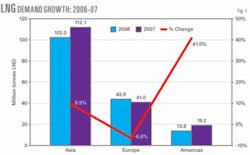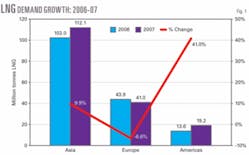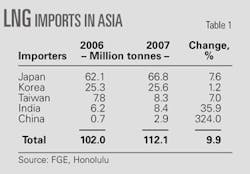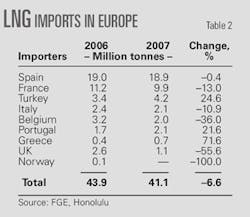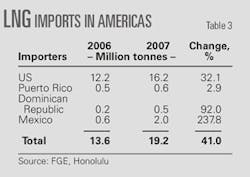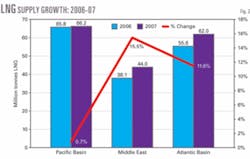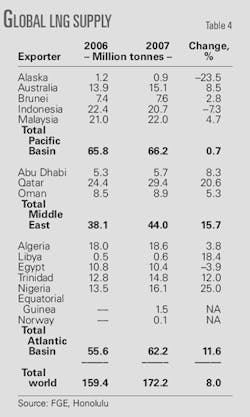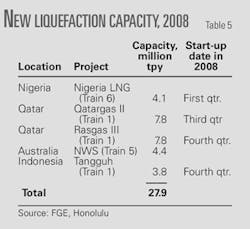In 2007, global LNG demand reached about 172.2 million tonnes, a rise of roughly 13 million tonnes (or 8%) compared with 2006. Fig. 1 shows the largest growth on a percentage basis occurred in the Americas (41%), followed by Asia (10%), while Europe (7%) declined.
Interestingly, the situation was the reverse of 2006, when Europe experienced the largest growth rate in imports due to a cold winter and strong demand in the UK. The Americas, on the other hand, saw imports decline by more than 7% due to mild weather and ample storage, which stabilized prices and enabled cargoes to be directed to other higher value markets, particularly Asia. Asian imports posted strong growth rates of 10% in 2006 and 11% in 2007, further cementing the region as the most stable, high growth market in the world.
Asia-Pacific
In 2007, LNG demand in the Asia-Pacific reached 112.1 million tonnes. Moreover, the region accounted for the largest regional global growth in absolute numbers: 10.1 million tonnes over 2006 levels.
Japan, the world’s largest LNG market for the second year running, led Asia-Pacific LNG importers in absolute growth. The rise in imports in 2007 can be attributed in part to economic recovery and attractive LNG prices compared with oil-based substitutes, which drove demand in the industrial sector.
In the power sector, demand for LNG expanded as power generation was affected by the closing of several nuclear power plants, most notably TEPCO’s Kashiwazaki-Kariwa nuclear plant, as well as low utilization of hydropower capacity due to lower-than-average precipitation.
In Korea, imports increased marginally by about 0.3 million tonnes compared with 2006. The relatively flat level of imports can be attributed to seasonally mild temperatures, particularly in the first half of the year, although imports began to pick up in the second half, driven by stronger sales in the power sector. These increased sales were due to the lower generation unit cost of gas vs. oil, coupled with relatively strong electricity demand.
In Taiwan, LNG imports were up a healthy 7% to 8.3 million tonnes year-on-year. The rise in imports was driven by the power sector and to a lesser extent the industrial sector, followed by the residential sector. Taiwan imports from the Atlantic Basin totaled about 1.21 million tonnes, with the largest supplies stemming from Equatorial Guinea, followed by Egypt and Nigeria.
The Atlantic Basin accounted for nearly 15% of Taiwan’s portfolio in 2007, a significantly higher share than that of the Asia-Pacific region as a whole, which stood at 7%.
Indian LNG imports totaled about 8.4 million tonnes in 2007, a substantial 36% increase from 2006, driven by strong demand in the industrial and residential sectors and substitution for naphtha in fertilizer production. India continues to be an active player in the spot market, importing about 42 cargoes in 2007. While a significant amount of these cargoes came from Qatar, roughly 1.2 million tonnes came from the Atlantic Basin, particularly Nigeria (0.69 million tonnes) and Algeria (0.37 million tonnes).
China National Offshore Oil Co.’s (CNOOC’s) Guangdong terminal received its first Australian cargo in late May 2006. Imports grew rapidly in 2007 and totaled 2.9 million tonnes by yearend. China also made its entry into the spot LNG market receiving its first cargo from Oman in April 2007 and six additional cargoes during the remainder of the year, with the bulk coming from Algeria.
Europe
In 2007, European LNG imports were down 2.9 million tonnes (or 6.6%) compared with 2006 (Table 2). Exceptionally warm temperatures since autumn 2006 curbed demand for heating in most Western European countries last winter, whereas first-quarter 2006 was colder than average. Moreover, hydropower generation increased in many European countries during first-half 2007 thanks to heavier rainfalls.
In Spain, the largest LNG market in Europe, LNG imports in 2007 were essentially flat compared with 2006. Imports decreased by about 0.1 million tonnes, or less than 1%. Natural gas demand dropped in the first quarter, primarily due to a mild winter and to robust hydropower generation following high precipitation in 2006 and early 2007.
The situation reversed itself, however, and LNG demand was especially strong in the last quarter as the country experienced colder temperatures, low hydropower generation (the rest of 2007 turned out to be dry), and maintenance at nuclear power plants.
In Belgium, Algerian LNG imports of less than 3.3 million tonnes/year (tpy), long-term contract have ceased and been replaced since April 2007 by a 2-million-tpy long-term contract between RasGas II and Distrigas. Low gas prices at the Zeebrugge Hub, however, have been unable to attract more than a couple of complementary spot cargoes and, consequently, LNG imports decreased by 1.2 million tonnes or 36% year-on-year.
In the UK, the start of two new pipelines at the end of 2006 (Langeled, 2.4 bscfd from Norway in September 2006; and the 1.5 bscfd Dutch Interconnector in December 2006) opened additional natural gas supply routes to the country.
This contributed to the fall of UK gas prices (which averaged around $6.00/MMbtu in 2007), deterring LNG imports despite the start of Excelerate’s Teesside onboard regasification terminal in February 2007. Total imports only reached 1.1 million tonnes for the year, a drop of more than 55% compared with 2006 and leaving the Teesside terminal empty during the whole year.
In 2007, only three southern European countries (Turkey, Portugal, and Greece) increased their LNG imports. Turkey’s imports rose about 25% (or nearly 0.8 million tonnes). The country experienced strong demand growth in the power and industrial sectors and had to make up for lost volumes due to pipeline supply disruptions from Iran in the last quarter, as Iran was experiencing one of the coldest winters on record.
LNG imports into Portugal and Greece in 2007 rose by roughly 0.4 million tonnes and 0.3 million tonnes, respectively, from 2006. Greece completed the expansion of DEPA’s Revithoussa terminal in September 2007 and received one additional cargo from Algeria in the same month. The country has not, however, signed any additional supply contract so far to feed the additional capacity in the terminal.
Americas
Warm weather in Western Europe led to record levels of LNG imports in the Americas, particularly through August, as the US confirmed its position as the market of last resort. As a result, LNG demand in the Americas increased by 5.6 million tonnes or 41% year-on-year driven primarily by US demand, which increased to 16.2 million tonnes.
In Mexico, the Altamira terminal, which received its first LNG cargo in August 2006, imported 2.0 million tonnes in 2007 from Nigeria, Egypt, and Trinidad. Imports will increase this year with the commencement of the Costa Azul terminal, though it remains to be seen how much LNG will be attracted to the West Coast terminal given strong demand in Asia.
Demand in the Dominican Republic also increased slightly due to the relaxation of tensions on Atlantic Basin supply.
LNG supply
In 2007, global LNG supply grew by about 13 million tonnes or 8% year-on-year. As was the case in 2006, production levels did not meet expected targets due to projects delays (NLNG Train 6), technical problems (Snohvit), feedstock shortages (SEGAS and Bontang), as well as unplanned outages (NWS). As Fig. 2 shows, the largest supply growth occurred in the Middle East at 15.5%, followed by the Atlantic Basin at 1.16%, and Pacific Basin at 0.7%.
LNG supply from the Middle East continues to grow on the increased output from Qatar and smaller increases from Oman and Abu Dhabi. Since 2006, Qatar has replaced Indonesia as the world’s largest LNG producer accounting for 29.4 million tonnes of exports in 2007. The incremental growth of 5 million tonnes year-on-year is primarily due to the start of RasGas Train 5 in December 2006.
LNG supply from Oman and Abu Dhabi also increased by 5.3% and 8.3%, respectively, during the same period. However, LNG production from Oman LNG and Qalhat LNG remain less than the liquefaction total capacity of 11 million tpy, as the country faces a domestic demand surge and gas supply crunch.
Algeria continues to be the largest producer in the Atlantic Basin with exports increasing by nearly 4% to 18.7 million tonnes. Nigeria, now the region’s second largest supplier, posted the largest growth (3.3 million tpy), primarily due to steadier production from NLNG Trains 4 and 5, which experienced production shortfalls in 2006.
Trinidad and Tobago also posted solid growth of 1.7 million tonnes year-on-year with production levels increasing to 14.4 million tonnes in 2007. Libyan exports were essentially flat year-on-year, whereas Egyptian production dropped by about 4% due to growing domestic demand and technical difficulties, which led to gas supply cuts to the Damietta plant.
Finally, the Atlantic Basin witnessed the entrance of two new LNG exporters in 2007, with the commencement of exports from Equatorial Guinea in May and Snohvit in October.
The Pacific Basin posted the smallest nominal increase (0.4 million tonnes). Australia represented the largest growth in LNG supply in the region for 2007 (averaging 8.5%/year). LNG supply from Australia increased to 15.1 million tonnes in 2007 from 13.9 million tonnes in 2006 because of a ramp up in the Darwin liquefaction plant. In Malaysia, LNG production from Bintulu was up 7% in 2007.
Indonesian LNG supply experienced a total decline in production of 1.7 million tonnes during 2006-07. The country continues to face production problems and has fallen to the third rank (after Qatar and Malaysia), down from being the world’s largest LNG producer. Finally, Brunei decreased its LNG supply by 0.4 million tonnes during 2007, when compared with 2006.
Table 4 illustrates global LNG supply by country in 2006-07.
New LNG supply
Qatar is expected to boost its liquefaction capacity with its new 7.8-million-tpy liquefaction trains. The first train of RasGas III is to be completed in October of this year. Qatargas II is also to commence its LNG supply from the first train in third-quarter 2008. With completion of these two mega trains by yearend 2008, total Qatari liquefaction capacity will jump to 45.9 million tpy from 30.3 million tpy.
LNG supply from the Atlantic Basin will see a large increase after completion of the new Nigeria LNG Train 6 and ramp up of LNG supply from Equatorial Guinea. Production from the Snohvit plant in Norway resumed in February 2008 and production should slowly ramp up this year.
In Asia-Pacific, Australian liquefaction capacity is to increase by 4.4 million tpy after completion of NWS Train 5 in late 2008. In Indonesia, Train 1 of the Tangguh LNG project is to be completed in late 2008. The BP-led Tangguh LNG project, however, is targeting next year for first exports from its two production trains.
FGE understands that start-up for Tangguh’s first train is currently scheduled for Oct. 17, 2008, with the first cargo of LNG expected to emerge 3 months later. The second train of Tangguh is due for start-up on Mar. 17, 2009, with first export cargo to follow on June 17, 2009.
In general, for 2008, a total of 27.9 million tonnes of new LNG capacity is expected to come on stream worldwide (Table 5).
Strong LNG demand
In Asia-Pacific, FGE expects an average 9.3% in LNG demand growth in 2008 in our base-case demand scenario for the region. China and India are to increase their LNG imports significantly. In China, LNG demand is to grow to 3.5 million tonnes this year from 2.9 in 2007.
In the Americas, construction of five new LNG terminals is to be completed by yearend 2008, bringing total regasification capacity to 101.5 million tpy by yearend 2008. The annual growth rate for LNG imports is to be lower than other regions. FGE’s base-case average growth estimation for 2007-08 indicates a 3.3%/year increase in LNG demand in the Americas.
For Europe, FGE’s forecasts in its base case is an average of 18.9%/year in LNG imports, as demand in northern Europe is to pick up compared with 2007 levels.
Currently, about 18.2 million tonnes of LNG regasification capacity is under construction in Europe and expected to come on stream by the end of this year. The Fos Cavaou terminal in France is currently under construction and expected to start its operations in late 2008 or early 2009. The terminal will receive Egyptian LNG supply.
In the UK, two LNG terminals are currently under construction. The UK is to be ready to receive its first cargo from Qatargas II after completion of its 7.8-million-tpy South Hook terminal at Milford Heaven.
In FGE’s base-case demand scenario, global LNG demand will increase to 191.2 million tonnes in 2008.
Although five new LNG production projects are to come on stream during 2008, supply will still have a hard time keeping up with growing demand pressure and LNG markets will likely continue to show high prices.
The authors
Shahriar Fesharaki ([email protected]), vice-chairman and member of the management and executive committees. He holds an MBA from the University of Hawaii with an emphasis on international business and previously worked for the Bank of Hawaii. His focus is on new business development, specifically looking at new growth opportunities for FGE. He also specializes in LNG marketing and is responsible for providing buyers and sellers with sourcing and placement strategies for LNG. As vice-chairman, he oversees gas consulting at FGE.
Siamak Adibi ([email protected]), senior consultant and coordinator of the Middle East gas team, specializes in natural gas and LNG businesses with a focus on the Middle East and Commonwealth of Independent States. He holds an MA from Tehran University in energy economics and was previously employed by the National Iranian Gas Export Co. (NIGEC).
